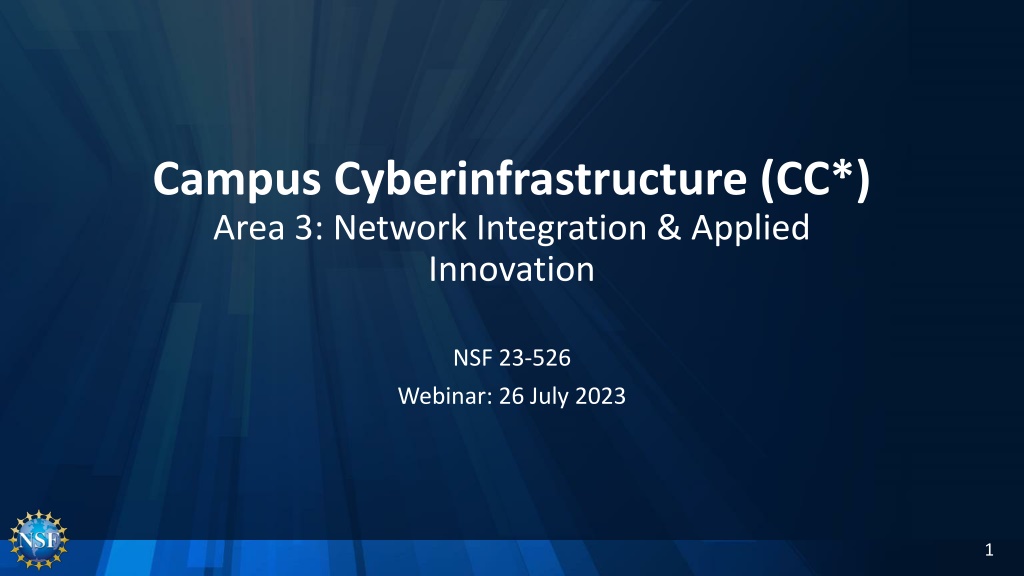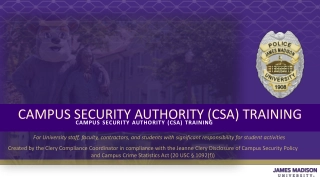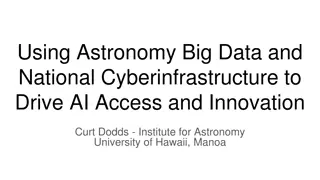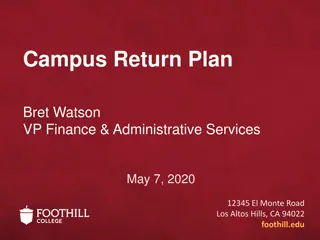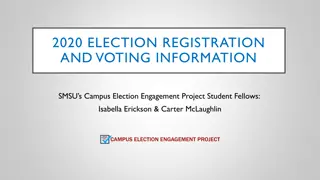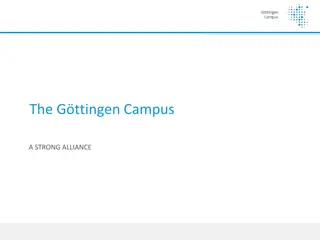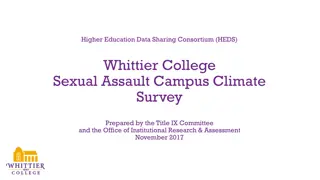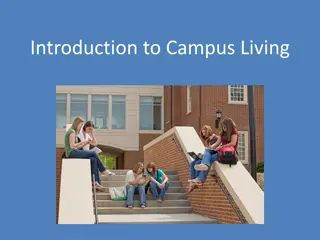Campus Cyberinfrastructure (CC*) Program Overview
This overview delves into the Campus Cyberinfrastructure (CC*) Program, emphasizing networking, funding opportunities, and key areas of focus for campus-level cyberinfrastructure improvements and innovation. Learn about the important role of networking in driving scientific research and education needs.
Download Presentation

Please find below an Image/Link to download the presentation.
The content on the website is provided AS IS for your information and personal use only. It may not be sold, licensed, or shared on other websites without obtaining consent from the author.If you encounter any issues during the download, it is possible that the publisher has removed the file from their server.
You are allowed to download the files provided on this website for personal or commercial use, subject to the condition that they are used lawfully. All files are the property of their respective owners.
The content on the website is provided AS IS for your information and personal use only. It may not be sold, licensed, or shared on other websites without obtaining consent from the author.
E N D
Presentation Transcript
Campus Cyberinfrastructure (CC*) Area 3: Network Integration & Applied Innovation NSF 23-526 Webinar: 26 July 2023 1
Program Directors Program Directors Area-3 Deep Medhi (CNS) Nicholas Goldsmith (CNS) Other Areas Kevin Thompson (OAC) Subrata Acharya (CNS) Pinhas Ben-Tzvi (ESPCoR) 2
Overview of CC* Overview of CC* 3
NSF 23 NSF 23- -526 526 Campus Cyberinfrastructure (CC*) Campus Cyberinfrastructure (CC*) The CC* solicitation invests in coordinated campus-level cyberinfrastructure improvements, innovation, integration, and engineering for science applications and distributed research projects. Science-driven requirements are the primary motivation for any proposed activity. All projects supported by CC* must be driven by STEM research and education needs that require the support of networking, computing, and storage infrastructure on campuses.
The Campus Cyberinfrastructure (CC*) Program The Campus Cyberinfrastructure (CC*) Program Networking as a fundamental layer and underpinning of Cyberinfrastructure, driven by scientific R&E needs Most awards go to High Speed Campus networking upgrades, external connectivity to the national R&E fabric, and campus border redesign prioritizing science traffic. Program is in its 12th year with different program areas expanding into other components of CI including computing and data CC* emphasizes strong campus level partnerships between researchers/teachers and campus IT leadership 5
State and Regional R&E Fabric State and Regional R&E Fabric 6
CC* 23 CC* 23- -526 526 - - Campus Cyberinfrastructure Campus Cyberinfrastructure https://www.nsf.gov/pubs/2023/nsf23526/nsf23526.htm $15M-$20M in expected award funding across all areas 30-50+ expected awards across all areas Proposals due September 11, 2023 Area #1 Campus Network upgrades Area #2 Regional Connectivity for Small Institutions Area #3 Networking Integration and Applied Innovation Area #4 Campus Computing Area #5 Regional Computing Area #6 Data Storage Area #7 Planning Grants and CI-Research Alignment
CC* Area 3 CC* Area 3 8
Network Integration & Applied Innovation Awards Network Integration & Applied Innovation Awards Supports end-to-end network CI through integration of existing and new technologies and applied innovation. The goal is to take advantage of research results, prototypes, and emerging innovations to use them to enable specified researchers in a networking context. Proposals in this area may leverage new and existing investments in network infrastructure, services, and tools by combining or extending capabilities to work as part of the CI environment used by scientific applications and users. Proposals in this area are expected to reflect innovation in advanced networking. As a result, this area is not appropriate for projects whose costs are dominated by equipment purchases. Proposals in this area support the development and integration of innovative networking capabilities and network-related software development, and deployment activities resulting in an operational environment prototype are expected to be part of the proposed activities. Additionally, proposals are encouraged to perform experimental deployment, protocol prototyping and testing, and evaluation using FABRIC (https://www.fabric-testbed.net) 9
A broad range of activities is covered by this A broad range of activities is covered by this area, including but not limited to: area, including but not limited to: Integration of networking protocols and technologies with science application layer processes and workflows, for instance, for large-scale shared scientific datasets and/or large-scale remote computational resources; Transition of successful research prototypes in Software-Defined Networking (SDN) and wireless networking technologies to distributed scientific environments and campus infrastructure; Applications of networking hardware and software developed on NSFFutureCloud facilities (e.g., ChameleonCloud and CloudLab), including the integration of new technologies such as programmable network interfaces; Networking solutions exploiting virtualization, distributed computing and Software-Defined Infrastructure (SDI), including cloud services and direct campus-to-cloud connections; Innovative research prototypes integrating programmable packet processing components into campus infrastructure or exploring applications of software-defined data planes in support of high-performance data distribution; and Network engineering support through the creation and application of new and novel procedures and tools and network measurement and monitoring software for solving end-to-end network performance issues, especially for dynamically constructed network services. 10
Area 3 Award Details Area 3 Award Details Two categories: Small: up to $500,000 Large: $500,001 to $1,000,000 Duration: up to 2 years Only Institutions of Higher Education are eligible to submit proposals in this program area Proposals due September 11, 2023 11
Proposal Requirements Proposal Requirements 12
CC* Area 3 Proposal Requirements CC* Area 3 Proposal Requirements Identify supported science or engineering research projects/applications and describe how the proposed network integration and applied innovation activities will support those projects Involve and support graduate students where appropriate Include a Project Plan addressing clear project goals and milestones resulting in a working system in the target environment Define base metrics; address measurement and evaluation of the system Open-source license for any software development under proposed activities Include a Campus CI plan as a Supplementary Document (see next slide) Titles begin with: "CC* Integration-Small": for proposed budgets of up to $500,000 "CC* Integration-Large:" for proposed budgets of between $500,001 and $1,000,000 13
Campus Cyberinfrastructure Plan Campus Cyberinfrastructure Plan The proposed cyberinfrastructure improvements are conceived, designed, and implemented in the context of a coherent campus-wide strategy An approach to cyberinfrastructure that is integrated horizontally intra- campus and vertically with regional and national cyberinfrastructure investments and best practices Must include sustainability of the proposed work in terms of ongoing operational and engineering costs Included as a Supplementary Document No more than 5 pages. Example CI Plans: https://fasterdata.es.net/nsf-docs/campusCIplanning/ 14
Review Criteria Review Criteria 15
National Science Board Merit Review Criteria National Science Board Merit Review Criteria Intellectual Merit: The potential to advance knowledge Broader Impacts: The potential to benefit society and contribute to the achievement of specific, desired societal outcomes 16
CC* CC*- -wise Solicitation Specific Review Criteria wise Solicitation Specific Review Criteria The extent to which the work provides a needed capability required by science, engineering and education. The expected impact on the deployed environment described in the proposal, and potential impact across a broader segment of the NSF community. Where applicable, how resource access control, federated identity management, and other cybersecurity related issues and community best practices are addressed. 17
Cyberinfrastructure Plan Review Criteria Cyberinfrastructure Plan Review Criteria To what extent is the planned cyberinfrastructure likely to enhance capacity for discovery, innovation, and education in science and engineering? How well does the plan as presented position the proposing institution(s) for future cyberinfrastructure development? How well does the cyberinfrastructure plan support and integrate with the institutions' science and technology plan? Are IPv6 deployment and InCommon Federation addressed? Are the activities described in the proposal consistent with the institution's cyberinfrastructure plan? 18
CC* Area 3 Solicitation Specific Review Criteria CC* Area 3 Solicitation Specific Review Criteria A Project Plan addressing clear goals and milestones resulting in a working system in the target environment. Tangible metrics to measure the success of the integrated systems and any associated software developed, and the steps necessary to take the systems from prototype status to production use. 19
Examples Examples 20
Examples of Funded Projects Examples of Funded Projects CC* Integration-Large: Q-Factor: A Framework to Enable Ultra High-Speed Data Transfer Optimization based on Real-Time Network State Information provided by Programmable Data Planes PI: Jeronimo Bezerra, Institution: Florida International University, Award Number: 2018754 CC* Integration-Large: mGuard: A Secure Real-time Data Distribution System with Fine-Grained Access Control for mHealth Research PI: Lan Wang, Institution: University of Memphis, Award Number: 2019085 CC* Integration-Large: Robust and Predictable Network Infrastructure for Wide- Area Hybrid Sensor Networks PI: Engin Arslan, Institution: University of Nevada - Reno, Award Number: 2019164 CC* Integration-Small: A Software-Defined Edge Infrastructure Testbed for Full- stack Data-Driven Wireless Network Applications PI: Flavio Esposito, Institution: Saint Louis University, Award Number: 2201536 21
Examples of Funded Projects with FABRIC Examples of Funded Projects with FABRIC CC* Integration-Small: Integrating Application Agnostic Learning with FABRIC for Enabling Realistic High-Fidelity Traffic Generation and Modeling PI: Deniz Gurkan, Institution: University of Houston, Award Number: 2018472 CC* Integration-Small: Harnessing FABRIC for Scalable Human Genome Sequence Analysis PI: Praveen Rao, Institution: University of Missouri, Award Number: 2201583 CC* Integration-Large: Prototyping a Secure Distributed Storage Infrastructure for Accelerating Big Science PI: Susmit Shannigrahi, Institution: Tennessee Technological University, Award Number: 2126148 22
Questions? Questions? Proposals due September 11, 2023 dmedhi@nsf.gov nicgolds@nsf.gov https://www.nsf.gov/pubs/2023/nsf23526/nsf23526.htm 23
